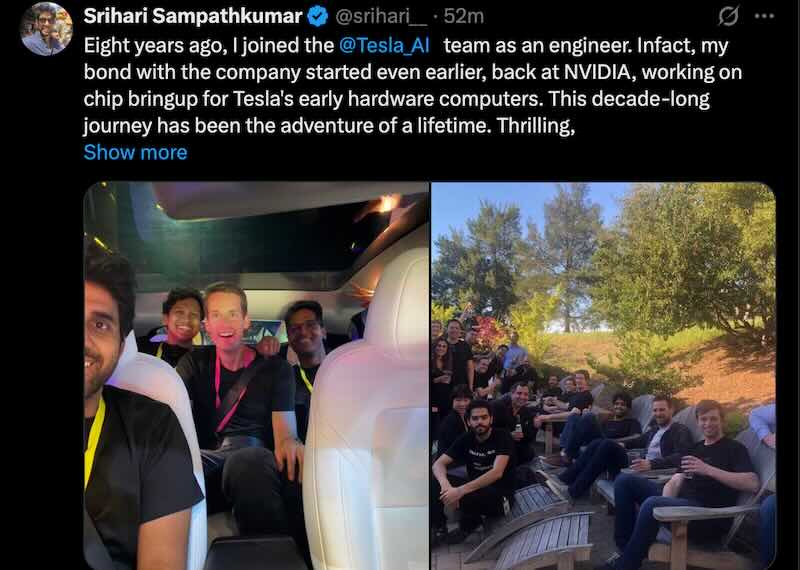Srihari Sampathkumar, senior Tesla AI engineering leader has announced his departure from the company after eight years of contributing to Autopilot and TeslaBot development. Who oversaw AI infrastructure and software engineering for Tesla’s autonomous driving systems, shared his decision on X, citing personal callings and the need to recharge after a decade-long sprint in artificial intelligence development.
The departure represents a significant personnel change for Tesla AI operations, particularly given the individual’s deep involvement in the company’s vision-only autonomous driving approach. His tenure spans critical periods of Tesla’s AI development, from early hardware partnerships to the recent Robotaxi announcements.

Srihari Sampathkumar Leaves After 8 Years of Autopilot Development
June, Tesla’s VP of AI and Optimus Engineering Milan Kovac announced his departure from the company. Who played crucial roles in developing Tesla’s FSD technology and Optimus robot projects, cited family obligations as his primary reason for leaving.
Srihari’s relationship with Tesla AI began even before joining the company directly, working at NVIDIA on chip development for Tesla’s early hardware computers. Background provided foundational experience in automotive AI hardware that proved valuable during Tesla’s transition to custom silicon solutions.
After joining Tesla’s AI team as an engineer eight years ago, he witnessed the company’s evolution from experimental autonomous driving features to production-ready systems. Journey encompassed Tesla’s shift to vision-only AI systems, powered exclusively by cameras and constrained to 200W of compute power in mass-manufactured vehicles.
Tesla AI development focused on solving what the Srihari described as “one of the hardest AI and engineering problems ever.” Challenge involved building real-world vision-only AI systems that could operate safely in real-time while maximizing intelligence per watt of compute power.
The engineering team’s approach differed from competitors by avoiding research silos and instead shipping incremental improvements to earn customer trust. This strategy allowed Tesla to gather real-world data while continuously improving system performance through over-the-air updates.
Srihari praised Tesla’s culture of “pure dedication and passion for the mission,” highlighting vertical integration across hardware, software, and AI as key factors in maintaining rapid innovation. Integrated approach enabled small, aligned teams to achieve significant technological advances.
Elon played a crucial role in driving the team’s success, with Srihari noting Elon’s “biological neural net” ability to predict future technological directions. Vision guided Tesla AI development through multiple challenging phases of autonomous driving technology.
Tesla Robotaxi and ongoing Optimus development represent the culmination of years of AI engineering work. Projects demonstrate Tesla’s ability to apply vision-only AI systems beyond automotive applications, potentially transforming multiple industries through scalable autonomous technology.
Srihari’s contributions to both Robotaxi and Optimus AI software engineering helped establish Tesla’s position in real-world AI applications. His work on AI software/hardware system co-design contributed to achieving high intelligence per watt performance metrics.
Srihari explicitly stated he isn’t joining any competitor, instead pursuing personal projects and ideas that align with his individual interests. Clarification addresses potential speculation about talent migration between autonomous driving companies.
Related Post
Tesla Optimus Robot Masters Complex Tasks Through Revolutionary Video Learning
Tesla Optimus Robot Masters Household Chores Through Human Video Learning
Tesla Model Y Completes First Fully Autonomous Vehicle Delivery from Factory to Customer Home
.png)



